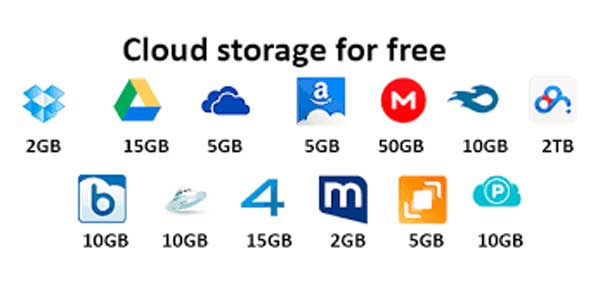
Ever found yourself frantically deleting old photos from your phone just to make space for new ones? Or maybe you’ve been that person emailing files to yourself because your USB drive decided to retire without notice? Yeah, I’ve been there too.
That’s when I discovered the magic of cloud storage. But here’s the thing—with so many options out there, how do you choose the right one without spending a dime? After years of testing, juggling accounts, and occasionally losing files (learning the hard way, of course), I’ve become somewhat of a cloud storage connoisseur.
Today, I’m sharing my personal rundown of the best free cloud storage options that offer the most bang for zero bucks. Whether you’re a student, a budding entrepreneur, or just someone who wants to free up phone space, there’s something here for you.
Table of Contents
What Exactly Is Cloud Storage Anyway?
Before we dive in, let’s get on the same page. Cloud storage is basically like having a virtual hard drive that you can access from anywhere with an internet connection. Instead of saving files to your computer or phone, you’re storing them on remote servers maintained by a storage provider.
The beauty of this? Your files aren’t tied to a single device. You can access your photos from your phone, your documents from your laptop, and that important presentation from your friend’s computer when you’re in a pinch.
“The cloud is just someone else’s computer,” they say. Well, if that someone else is providing me with free storage space and keeping my files safe, I’m totally okay with that!
How I Tested These Cloud Storage Services
I didn’t just glance at their features pages and call it a day. I actually signed up for each service, uploaded various file types (documents, photos, videos), tested the sync capabilities across devices, examined the sharing options, and even checked out their mobile apps.
Most importantly, I paid close attention to the limitations of their free plans. Because let’s be real—nothing is truly “unlimited,” even if they claim to be. There’s always a catch, whether it’s file size limits, bandwidth restrictions, or fewer features than paid plans.
Pro Tip:
Don’t put all your digital eggs in one basket. I recommend using at least two different cloud services—one for your most critical files and another for backups. This way, if one service has issues or changes their terms, you’re not left scrambling.
The Top 10 Free Cloud Storage Services
1. Google Drive – The All-Rounder
If you have a Google account (and who doesn’t these days?), you already have access to Google Drive. It seamlessly integrates with Google’s suite of productivity tools like Docs, Sheets, and Slides, which is incredibly convenient for collaboration.
Free storage: 15GB
Maximum file size: 5TB (yes, terabytes!)
Special features: Tight integration with Google Workspace, advanced sharing permissions, works across all platforms
Pros
- Generous 15GB free storage
- Excellent collaboration features
- Powerful search functionality
- Reliable and fast syncing
Cons
- 15GB is shared across Gmail and Google Photos
- Privacy concerns (Google scans your files)
- Web interface can feel cluttered
Best for: Anyone already in the Google ecosystem, students, collaborators
2. Dropbox – The Pioneer
Dropbox practically invented the modern cloud storage game. While their free offering isn’t the most generous in terms of space, the reliability and simplicity of their service keep them in the top tier.
Free storage: 2GB (with ways to earn more)
Maximum file size: 50GB for paid users, 2GB for free (via browser)
Special features: File recovery and version history for 30 days, shared folders, Dropbox Transfer for sending large files
Pros
- Super reliable syncing
- Clean, intuitive interface
- Excellent file versioning
- Can earn extra free space
Cons
- Only 2GB base free storage
- Limited features on free plan
- Frequent upsell prompts
Best for: Those who value reliability, cross-platform compatibility
3. Mega – The Privacy Champion
Mega offers the most generous free storage plan on the market. Founded by Kim Dotcom as a privacy-focused alternative to other services, it features end-to-end encryption right out of the box.
Free storage: 20GB (initially 15GB + 5GB for installing mobile app)
Maximum file size: Unlimited for free accounts
Special features: End-to-end encryption, secure chat functionality, file versioning
Pros
- Massive free storage allowance
- Strong security and privacy features
- No file size restrictions
- Built-in file expiration for sharing
Cons
- Encryption can slow down transfers
- Complex interface for beginners
- Controversial history of founder
Best for: Privacy-conscious users, those needing lots of free space
4. pCloud – The Media Lover’s Choice
pCloud stands out with its unique offering of lifetime plans (though we’re focusing on the free tier here). It features built-in audio and video players, making it excellent for media consumption directly from the cloud.
Free storage: 10GB
Maximum file size: Unlimited
Special features: Media playback, file versioning for 30 days, pCloud Crypto for encrypted files
Pros
- Excellent media playback features
- No file size limits
- Can earn up to 10GB more through referrals
- Fast upload/download speeds
Cons
- Only 10GB free space
- Advanced encryption costs extra
- Limited collaboration features
Best for: Media storage and streaming, personal file backup
5. OneDrive – Microsoft’s Ecosystem Player
If you live in the Microsoft universe, OneDrive integrates seamlessly with Windows and Office applications. The free storage isn’t massive, but the integration might make it worthwhile for Windows users.
Free storage: 5GB
Maximum file size: 100GB
Special features: Deep Windows integration, Office Online collaboration, Personal Vault for sensitive files
Pros
- Excellent Windows integration
- Good Office Online integration
- Personal Vault security feature
- Files-on-Demand feature saves local space
Cons
- Only 5GB free storage
- Less intuitive on non-Windows devices
- Limited features compared to competitors
Best for: Windows users, Microsoft Office enthusiasts
6. Box – The Business-Oriented Option
Box primarily targets business users, but its free personal plan offers some unique features that might appeal to certain users, especially those interested in workflow automation.
Free storage: 10GB
Maximum file size: 250MB (a significant limitation)
Special features: Strong collaboration tools, workflow automation, good security practices
Pros
- Good free storage amount
- Excellent collaboration features
- Strong security and compliance
- Workflow automation tools
Cons
- Small 250MB file size limit
- Geared more toward businesses
- Can be complex for personal use
Best for: Business users, those needing workflow tools
7. Sync.com – The Security-Focused Choice
Sync.com places a strong emphasis on security and privacy, offering zero-knowledge encryption on all files. Their free plan is reasonably generous and focused on secure file sharing.
Free storage: 5GB
Maximum file size: Unlimited
Special features: Zero-knowledge encryption, secure sharing links, password protection and expiration for shared files
Pros
- Strong security and privacy
- No file size limits
- Secure sharing options
- Can earn extra storage through referrals
Cons
- Only 5GB free storage
- Slower speeds due to encryption
- Limited third-party integrations
Best for: Security-conscious users, secure file sharing
8. MediaFire – The Ad-Supported Option
MediaFire has been around for ages and offers a straightforward cloud storage solution supported by ads. They offer a decent amount of free storage with options to earn more.
Free storage: 10GB
Maximum file size: 20GB
Special features: One-time links, direct download links, ad-supported model
Pros
- Good free storage amount
- Large file size limit
- Can earn up to 50GB through various actions
- Simple file sharing
Cons
- Ad-supported interface
- Fewer features than competitors
- Privacy concerns with ad model
Best for: Casual users, simple file sharing needs
9. iCloud Drive – The Apple Ecosystem
If you’re fully invested in the Apple ecosystem, iCloud Drive offers seamless integration across your Apple devices. The free storage is minimal, but the convenience might be worth it for Apple fans.
Free storage: 5GB
Maximum file size: 50GB (via iCloud website)
Special features: Deep integration with iOS/macOS, automatic device backups, Family Sharing
Pros
- Seamless Apple ecosystem integration
- Automatic device backups
- Family Sharing option
- Easy to use for Apple users
Cons
- Only 5GB free storage
- Limited functionality on non-Apple devices
- Web interface is basic
Best for: Apple device users, iPhone/iPad backup
10. Amazon Drive – The Prime Perk
Amazon Drive offers limited free storage to all users, but if you’re an Amazon Prime member, you get a significant upgrade specifically for photos. It’s worth considering if you’re already paying for Prime.
Free storage: 5GB for everyone, unlimited photo storage for Prime members
Maximum file size: 2GB (via browser), 50GB (via desktop app)
Special features: Prime membership benefits, family vault for sharing photos, facial recognition tagging
Pros
- Unlimited photo storage for Prime members
- Good organization features
- Family sharing options
- Integration with Amazon devices
Cons
- Only 5GB for non-photo files
- Confusing pricing structure
- Limited collaboration features
Best for: Amazon Prime members, photo storage

Comparison Table: Free Cloud Storage Services At A Glance
| Service | Free Storage | Max File Size | Special Features | Best For |
|---|---|---|---|---|
| Google Drive | 15GB | 5TB | Google Workspace integration | Google ecosystem users |
| Dropbox | 2GB | 2GB (via browser) | Reliable syncing, file recovery | Cross-platform reliability |
| Mega | 20GB | Unlimited | End-to-end encryption | Privacy-conscious users |
| pCloud | 10GB | Unlimited | Media playback, lifetime plans | Media storage & streaming |
| OneDrive | 5GB | 100GB | Windows integration | Windows/Microsoft users |
| Box | 10GB | 250MB | Workflow automation | Business users |
| Sync.com | 5GB | Unlimited | Zero-knowledge encryption | Secure file sharing |
| MediaFire | 10GB | 20GB | Ad-supported, simple sharing | Casual users |
| iCloud Drive | 5GB | 50GB | Apple ecosystem integration | Apple device users |
| Amazon Drive | 5GB (unlimited photos for Prime) | 2GB-50GB | Prime membership benefits | Prime members, photo storage |
How To Choose The Right Free Cloud Storage For You
With all these options, how do you pick the right one? Here’s what I consider when recommending a service to friends:
Consider Your Primary Use Case
Are you mainly storing documents? Photos? Large video files? Different services excel in different areas:
- For photos: Google Drive, Amazon Drive (if Prime), or pCloud
- For documents: Google Drive or Dropbox
- For large files: Mega or pCloud (no size limits)
- For collaboration: Google Drive or Box
- For privacy: Mega or Sync.com
Think About Your Ecosystem
If you’re deeply embedded in a particular ecosystem (Apple, Google, Microsoft), it often makes sense to use their cloud service for better integration. The convenience of having everything work together seamlessly might outweigh having slightly less storage space.
Consider Future Needs
While you might be fine with free storage now, think about whether you might need to upgrade later. Some services have more affordable upgrade paths than others. For example, Google Drive’s paid plans start at $1.99/month for 100GB, while Dropbox starts at $9.99/month for 2TB (quite a difference!).
Pro Tip:
Use multiple services! I personally use Google Drive for collaboration and documents, pCloud for media storage, and Mega for sensitive files. This way, I maximize the free storage available across platforms while keeping my eggs in different baskets.
Maximizing Your Free Cloud Storage
Okay, so you’ve picked a service (or two). How do you make the most of that free space? Here are some strategies I’ve developed over the years:
1. Clean Up Regularly
Just like your physical space, digital storage needs occasional decluttering. Set a calendar reminder every few months to go through your cloud storage and delete files you no longer need.
2. Compress Files Before Uploading
For documents and especially images, compression can significantly reduce file sizes without noticeable quality loss. Tools like TinyPNG for images or built-in compression features in document software can help stretch your storage further.
3. Take Advantage of Referral Programs
Many services offer additional free space for referring friends. Dropbox gives you 500MB per referral (up to 16GB), while Mega offers temporary bonuses for referrals. Sync.com and pCloud also have referral programs that can net you extra space.
4. Use Selective Sync
If your cloud service offers a desktop app, it likely has selective sync options. This allows you to choose which folders sync to your computer, saving local storage space while keeping everything accessible via the web interface.
5. Optimize Photo and Video Uploads
Some services like Google Photos offer “high quality” rather than “original quality” uploads that don’t count against your storage quota. If absolute original quality isn’t critical, this can save tremendous amounts of space.
Potential Drawbacks of Free Cloud Storage
While free cloud storage is amazing, it’s not without its potential issues. Here’s what to watch out for:
Privacy Concerns
Remember the old saying, “If you’re not paying for the product, you are the product”? Many free services make money by scanning your files to serve targeted ads or by upselling you to paid plans. If privacy is a concern, opt for services with end-to-end encryption like Mega or Sync.com.
Limited Support
Free plans typically come with limited or no customer support. If something goes wrong, you might be stuck with community forums or knowledge bases rather than direct help.
Service Changes
Free services can change their terms, reduce storage, or even shut down entirely. Remember when Microsoft reduced their OneDrive free storage from 15GB to 5GB? Always have important files backed up in multiple places.
Security Risks
While cloud providers generally have good security, any online service can potentially be breached. Use strong, unique passwords and enable two-factor authentication wherever possible to protect your accounts.
“The cloud is someone else’s computer” isn’t just a funny saying—it’s a reminder that your files are only as secure as the service protecting them. Choose wisely based on your security needs.
Frequently Asked Questions (FAQs)
Is free cloud storage really free forever?
Yes, the free tiers are typically free forever. However, providers may change their offerings over time (as Microsoft did when they reduced OneDrive storage). Always read the current terms of service, and don’t rely solely on free storage for critical files.
Can I use multiple cloud storage services at once?
Absolutely! In fact, I recommend it. Using multiple services allows you to take advantage of different strengths and provides backup redundancy. Tools like cloud storage managers can help you manage multiple accounts from one interface.
What happens if I exceed my free storage limit?
It varies by service. Some will stop syncing new files, others might prevent you from uploading until you free up space or upgrade to a paid plan. Most will send you warnings as you approach your limit.
Are there any hidden costs with free cloud storage?
Generally no, but be cautious of services that might charge for certain features like downloading large files or accessing premium support. Always read the fine print before signing up.
Which free cloud storage is most secure?
Mega and Sync.com are among the most secure options with their end-to-end encryption implementations. However, no online service is 100% hack-proof, so consider encrypting sensitive files before uploading them anywhere.
Can I upgrade from a free plan later?
Yes, all these services offer paid plans with more storage and features. The upgrade process is typically seamless—your files remain intact, and you simply gain additional space and capabilities.
Is it safe to store personal photos in free cloud storage?
For most people, yes. But if you have highly sensitive personal photos, you might want to use an encrypted service or encrypt the files yourself before uploading. Remember that some services offer end-to-end encryption for added security.
How often should I back up files to cloud storage?
It depends on how frequently your files change. For important documents that change often, consider continuous sync or daily backups. For less critical files, weekly or monthly backups might suffice. Many cloud services offer automatic syncing so you’re always backed up.
Can I share files with non-users through free cloud storage?
Yes, most services allow you to generate shareable links that anyone can access, even without an account. You can often set passwords and expiration dates on these links for added security.
What’s the difference between cloud storage and cloud backup?
Cloud storage is typically for active files you want to access and share regularly. Cloud backup is for automatically backing up your entire system or specific folders for disaster recovery. Some services like IDrive offer both storage and backup features.
Final Thoughts
Choosing the right free cloud storage ultimately comes down to your specific needs, preferences, and which ecosystem you’re already invested in. There’s no one-size-fits-all solution, but hopefully this guide has helped you narrow down the options.
My personal recommendation? Start with Google Drive if you’re already using Gmail and Google services. Supplement it with Mega for large files or sensitive documents that need extra security. And if you’re an Amazon Prime member, definitely take advantage of that unlimited photo storage—it’s one of the most underrated Prime benefits!
Remember, the best cloud storage is the one you’ll actually use consistently. So pick one that fits seamlessly into your workflow, and start enjoying the freedom that comes with having your files accessible anywhere, anytime.
What’s your favorite free cloud storage service? Did I miss any good options? Let me know in the comments!














Thank you so much for sharing a great post.
Welcome here and thanks for reading our article and sharing your view. This will be very helpful to us to let us motivate to provide you with more awesome and valuable content from a different mind. Thanks again.
Thanks for the list. Another alternative I’ve found that offers free space is Fireload.
Welcome here and thanks for reading our article and sharing your view. This will be very helpful to us to let us motivate to provide you with more awesome and valuable content from a different mind. Thanks again.